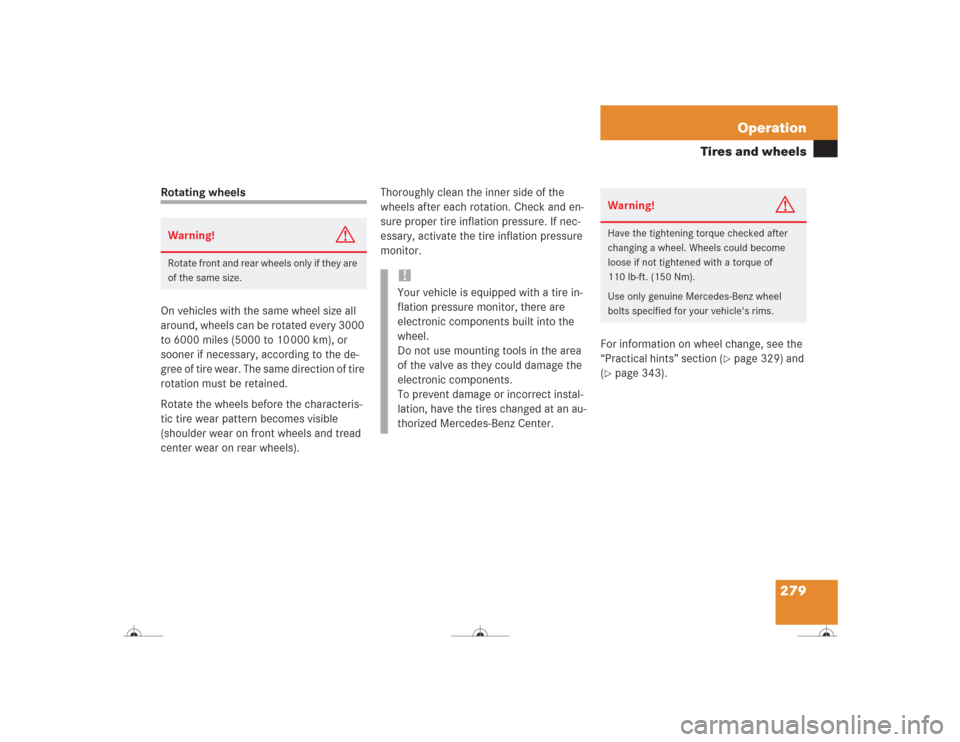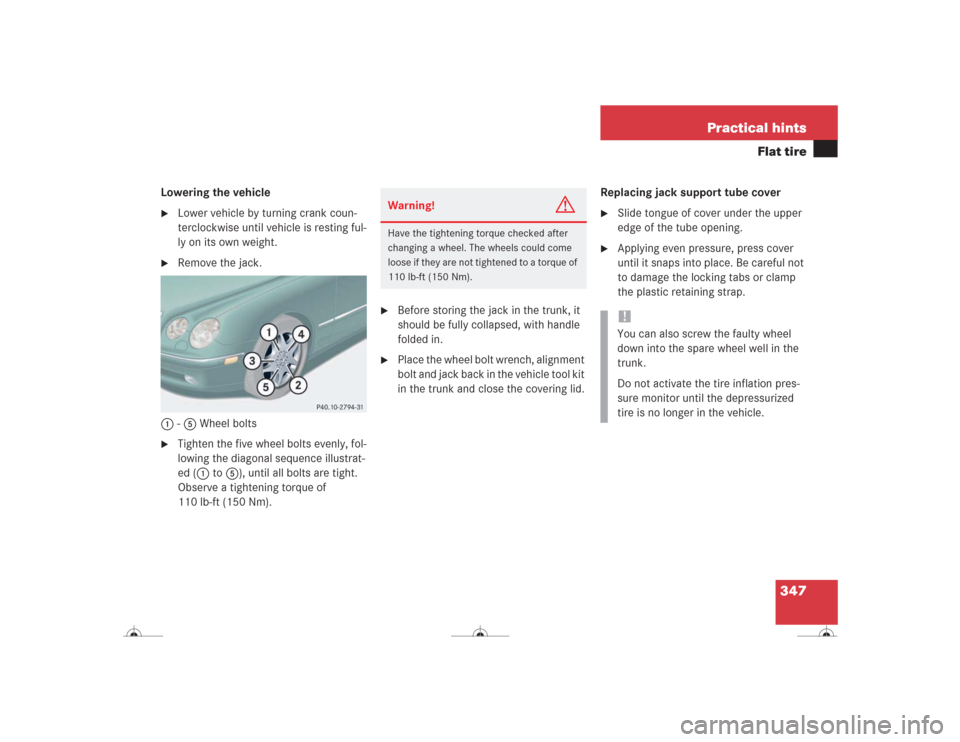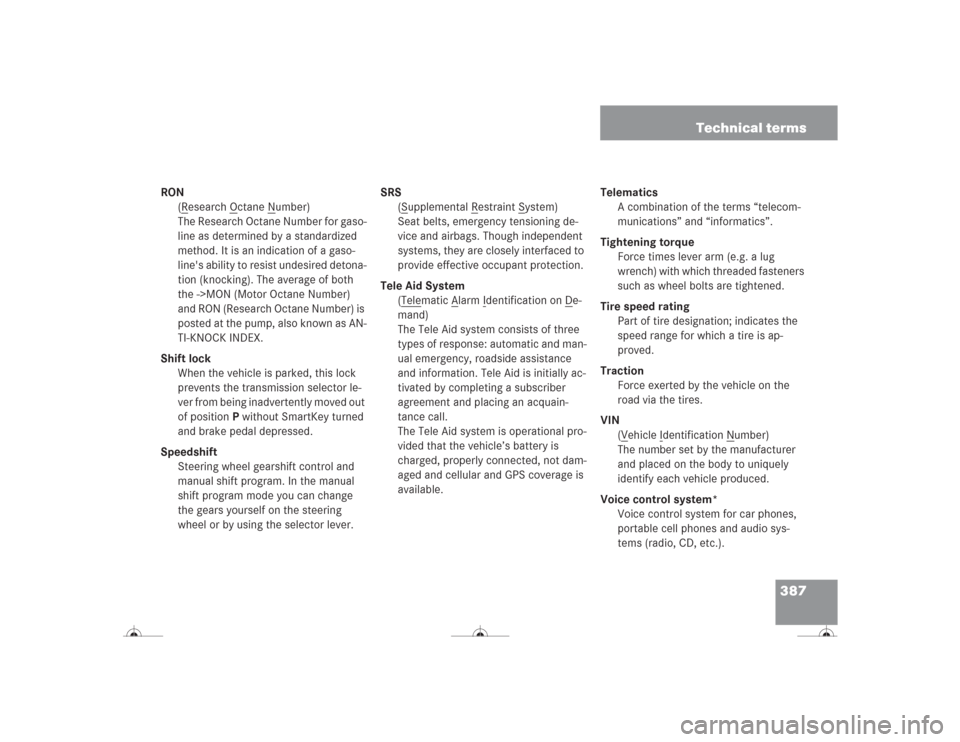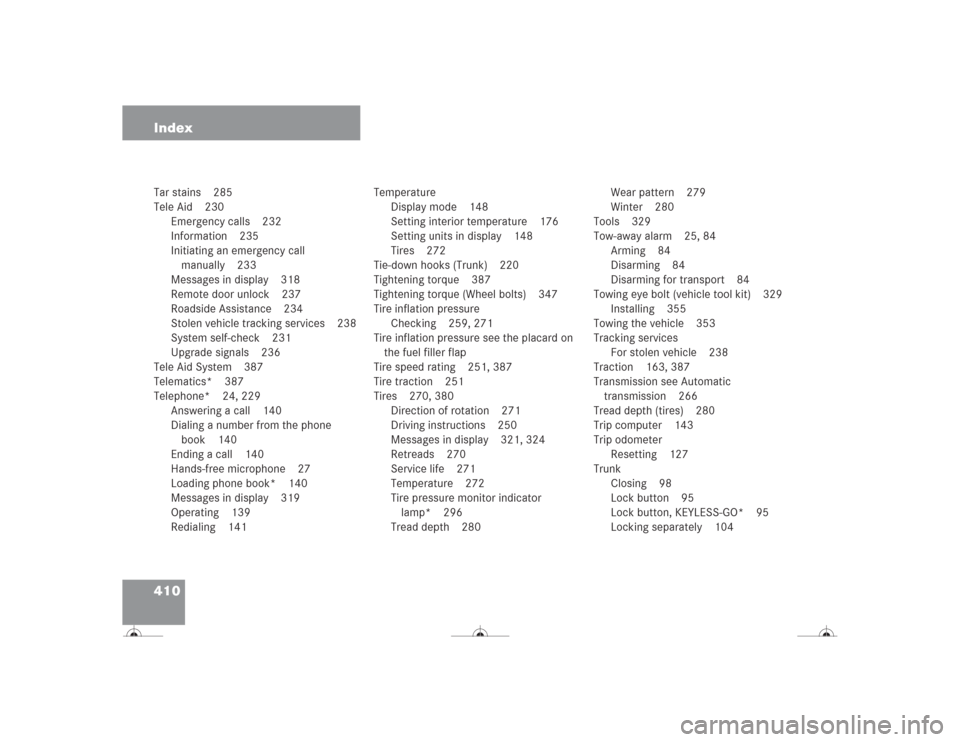Page 280 of 418

279 Operation
Tires and wheels
Rotating wheels
On vehicles with the same wheel size all
around, wheels can be rotated every 3000
to 6000 miles (5000 to 10 000 km), or
sooner if necessary, according to the de-
gree of tire wear. The same direction of tire
rotation must be retained.
Rotate the wheels before the characteris-
tic tire wear pattern becomes visible
(shoulder wear on front wheels and tread
center wear on rear wheels).Thoroughly clean the inner side of the
wheels after each rotation. Check and en-
sure proper tire inflation pressure. If nec-
essary, activate the tire inflation pressure
monitor.
For information on wheel change, see the
“Practical hints” section (
�page 329) and
(
�page 343).
Warning!
G
Rotate front and rear wheels only if they are
of the same size.
!Your vehicle is equipped with a tire in-
flation pressure monitor, there are
electronic components built into the
wheel.
Do not use mounting tools in the area
of the valve as they could damage the
electronic components.
To prevent damage or incorrect instal-
lation, have the tires changed at an au-
thorized Mercedes-Benz Center.
Warning!
G
Have the tightening torque checked after
changing a wheel. Wheels could become
loose if not tightened with a torque of
110 lb-ft. (150 Nm).
Use only genuine Mercedes-Benz wheel
bolts specified for your vehicle's rims.
Page 348 of 418

347 Practical hints
Flat tire
Lowering the vehicle�
Lower vehicle by turning crank coun-
terclockwise until vehicle is resting ful-
ly on its own weight.
�
Remove the jack.
1-5 Wheel bolts
�
Tighten the five wheel bolts evenly, fol-
lowing the diagonal sequence illustrat-
ed (1 to5), until all bolts are tight.
Observe a tightening torque of
110 lb-ft (150 Nm).
�
Before storing the jack in the trunk, it
should be fully collapsed, with handle
folded in.
�
Place the wheel bolt wrench, alignment
bolt and jack back in the vehicle tool kit
in the trunk and close the covering lid.Replacing jack support tube cover
�
Slide tongue of cover under the upper
edge of the tube opening.
�
Applying even pressure, press cover
until it snaps into place. Be careful not
to damage the locking tabs or clamp
the plastic retaining strap.
Warning!
G
Have the tightening torque checked after
changing a wheel. The wheels could come
loose if they are not tightened to a torque of
110 lb-ft (150 Nm).
!You can also screw the faulty wheel
down into the spare wheel well in the
trunk.
Do not activate the tire inflation pres-
sure monitor until the depressurized
tire is no longer in the vehicle.
Page 388 of 418

387 Technical terms
RON
(R
esearch O
ctane N
umber)
The Research Octane Number for gaso-
line as determined by a standardized
method. It is an indication of a gaso-
line's ability to resist undesired detona-
tion (knocking). The average of both
the ->MON (Motor Octane Number)
and RON (Research Octane Number) is
posted at the pump, also known as AN-
TI-KNOCK INDEX.
Shift lock
When the vehicle is parked, this lock
prevents the transmission selector le-
ver from being inadvertently moved out
of positionP without SmartKey turned
and brake pedal depressed.
Speedshift
Steering wheel gearshift control and
manual shift program. In the manual
shift program mode you can change
the gears yourself on the steering
wheel or by using the selector lever. SRS
(S
upplemental R
estraint S
ystem)
Seat belts, emergency tensioning de-
vice and airbags. Though independent
systems, they are closely interfaced to
provide effective occupant protection.
Tele Aid System
(T
elematic A
larm I
dentification on D
e-
mand)
The Tele Aid system consists of three
types of response: automatic and man-
ual emergency, roadside assistance
and information. Tele Aid is initially ac-
tivated by completing a subscriber
agreement and placing an acquain-
tance call.
The Tele Aid system is operational pro-
vided that the vehicle’s battery is
charged, properly connected, not dam-
aged and cellular and GPS coverage is
available.Telematics
A combination of the terms “telecom-
munications” and “informatics”.
Tightening torque
Force times lever arm (e.g. a lug
wrench) with which threaded fasteners
such as wheel bolts are tightened.
Tire speed rating
Part of tire designation; indicates the
speed range for which a tire is ap-
proved.
Traction
Force exerted by the vehicle on the
road via the tires.
VIN
(V
ehicle I
dentification N
umber)
The number set by the manufacturer
and placed on the body to uniquely
identify each vehicle produced.
Voice control system*
Voice control system for car phones,
portable cell phones and audio sys-
tems (radio, CD, etc.).
Page 411 of 418

410 IndexTar stains 285
Tele Aid 230
Emergency calls 232
Information 235
Initiating an emergency call
manually 233
Messages in display 318
Remote door unlock 237
Roadside Assistance 234
Stolen vehicle tracking services 238
System self-check 231
Upgrade signals 236
Tele Aid System 387
Telematics* 387
Telephone* 24, 229
Answering a call 140
Dialing a number from the phone
book 140
Ending a call 140
Hands-free microphone 27
Loading phone book* 140
Messages in display 319
Operating 139
Redialing 141Temperature
Display mode 148
Setting interior temperature 176
Setting units in display 148
Tires 272
Tie-down hooks (Trunk) 220
Tightening torque 387
Tightening torque (Wheel bolts) 347
Tire inflation pressure
Checking 259, 271
Tire inflation pressure see the placard on
the fuel filler flap
Tire speed rating 251, 387
Tire traction 251
Tires 270, 380
Direction of rotation 271
Driving instructions 250
Messages in display 321, 324
Retreads 270
Service life 271
Temperature 272
Tire pressure monitor indicator
lamp* 296
Tread depth 280Wear pattern 279
Winter 280
Tools 329
Tow-away alarm 25, 84
Arming 84
Disarming 84
Disarming for transport 84
Towing eye bolt (vehicle tool kit) 329
Installing 355
Towing the vehicle 353
Tracking services
For stolen vehicle 238
Traction 163, 387
Transmission see Automatic
transmission 266
Tread depth (tires) 280
Trip computer 143
Trip odometer
Resetting 127
Trunk
Closing 98
Lock button 95
Lock button, KEYLESS-GO* 95
Locking separately 104